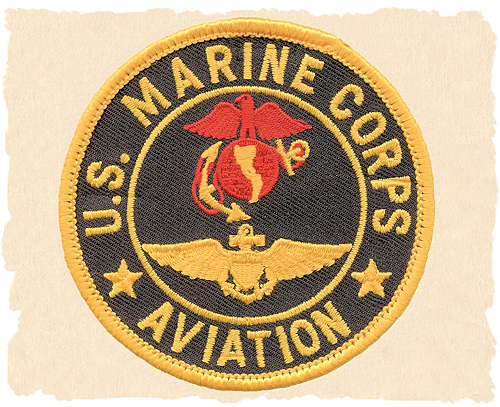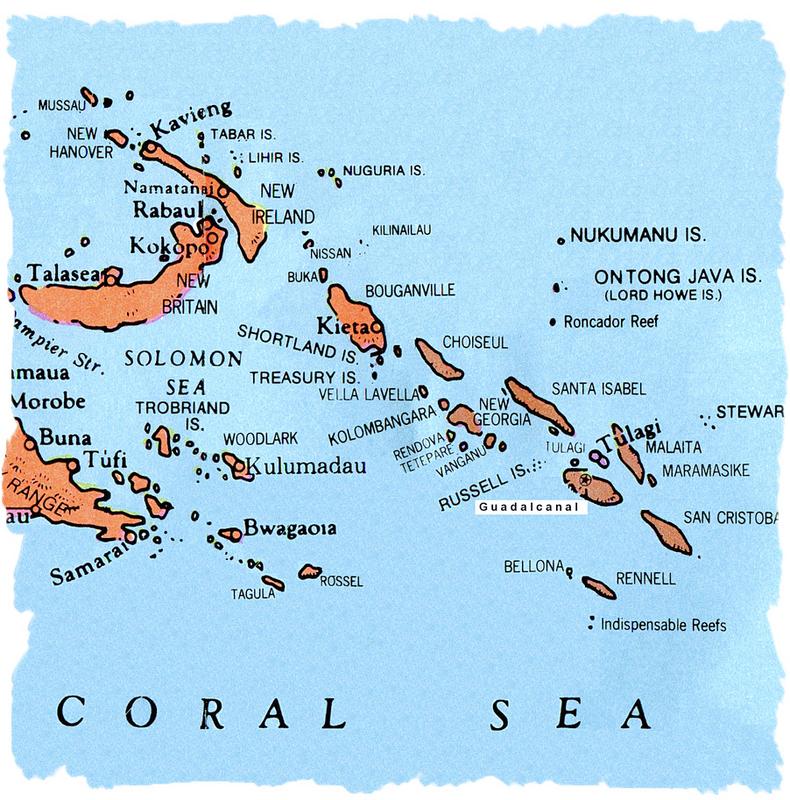VMF-224 Scrap Book
Guadalcanal
Squadron Notes
Overview of Squadron Activities
May 1942 ~ December 1943
May 1, 1942 VMF-224 was commissioned at Marine
Corps Air Station - Ewa, Territory of Hawaii and
placed under the command of Captain
trained through August 15, 1942.
Note: As of June 30, 1942 Marine Corps Aviation
consisted of 2 Air Wings, 10 Aircraft Groups,
31 Squadrons & 1,369 Pilots.
August 30, 1942 VMF-224 arrived at Henderson
Field, Guadalcanal.
Left "Santos" at 11:00 for Guadalcanal. A long, hot
ride at best. Almost got sick and plane didn't act
too well. Arrived Guadalcanal about 2:30 - two
planes had to turn back. Sure a bomb-scared field -
wrecked airplanes all over. Landed ok and saw the
boys in 223. Have to sleep on the ground in my
clothes tonight. (from S.S. Nicolay Diary)
The first pilots operated under a score of
handicaps which would not be substantially
eased until hundreds of Pilots had struggled
through the same handicaps for nearly half a
year. Henderson Field was a bowl of black dust
which fowled airplane engines or it was a
quagmire of black mud which made the take-off
resemble nothing more than a fly trying to rise
from a runway of molasses.
Text from the book:
"History of Marine Corps Aviation in WWll" page 82.
Early flight pilots were up an hour before dawn – ate a slim breakfast or gulped coffee – bumped down to the field - warmed up their engines and were ready to go at dawn –planes often had to be horsed out of revetments and onto the runway by tractors. Mail came infrequently, no extra clothes – in a few weeks they looked like a ragged rebel army, no flooring in tents – bunks just sank into the stinking black mud, any gear or equipment they had was so moldy in a few weeks it wasn’t fit to use.
Text from the book: "Devil-Birds, The Story of United States Marine Corps Aviation in WWll" pages 69 & 70.
September 2, 1942 Second Lts. Howard L. WALTER and Mathew H. KENNEDY arrived and joined the squadron. General Roy S. GEIGER, Commanding General of 1st MAW, Col. L.E. WOODS, Chief of Staff, and Lt. Col. J.C. MUNN arrived at Guadalcanal.
Intercept enemy bomber force consisting of 18 improved Mitsubishi 97's (B-26 type) and 28 Nagoya's. Robert E. GALER shot down 2 bombers. John M. JONES and George L. HOLLOWELL shot down one bomber each.
Living conditions were appalling. Pilots had to fight and fly all day on a diet of dehydrated potatoes, spam or cold hash and sometimes Japanese rice ….. sleeping in a mud-floored tent was constantly interrupted by Japanese cruiser planes which flew around murdering sleep and dropping occasional bombs, or by destroyers or submarines which stood offshore and lobbed shells at Henderson Field.
Text from the book: "History of Marine Corps Aviation in WWll" page 84
September 4, 1942 Rained hard last night. Woke up my feet in a puddle of water. Found my bed-roll in the hanger
this am - not so wet ...... found most of my gear except records. (from S.S. Nicolay Diary)
September 5, 1942 Intercept enemy force. Robert E. GALER and S.S. NICOLAY each shot down one enemy aircraft. C.D. GARRABRANT failed to return and was last seen in action with enemy. Robert A. JEFFERIES Jr. failed to return from a strafing mission.
Sub shelled us last night - killed a few men back in the hills. None hit near us. Got myself a bomber today. Got to take a bath and shave in the river. That's the best part the day. (from S.S. Nicolay Diary)
September 6, 1942 Second Lt. AMERINE, who had been missing since the flight of August 31st, was assisted to the base hospital by friendly ground troops whom he found on 6 September 1942. Lt. AMERINE reported that on the flight of August 31st, he was forced to parachute from his (F4F) plane because motor trouble and lack of oxygen. Landing in the sea, he shed his outer clothing and swam ashore. During his search for his station, he was able to elude hostile pursuers and kill four of the enemy's troops, one with a rock and the others with the gun he had taken from the body of the first. His only subsistence during his six days of wandering consisting of three coconuts.
General says to bomb Gezo, so they bomb Gezo. Not such good weather on the way up. Six fighters escorted the SBD's. Didn't see an enemy plane during the whole trip. Ran into a lot of bad weather on the trip back. Three SBD's lost in one particularly bad storm. Captain Brown was one of them. What a hell of and expensive expedition. Worst flight I have ever had - didn't know whether we were going to get back or not. (from S.S. Nicolay Diary)
September 7, 1942 Rained hard last night and a good part of the day. Got lots of work done for a change, but was so wet it was pretty miserable. Lots of people down with dysentery - had a touch of it myself yesterday. So far have been pretty lucky that way. Had time to write some letters. Slim (D. Irwin) and I finally found our records in pretty good shape. Still no laundry bag. Food was very bad tonight - most of the men went hungry and wet. (from S.S. Nicolay Diary)
September 8, 1942
On the afternoon of 8 September, 16 F4F’s took off during an alert in the rain and fog. As the weather worsened and darkness fell Munn persuaded Geiger to recall the planes and they came in between 1900 and 1930 trying to land on the deeply rutted strip. One pilot crashed into a bulldozer. Four others cracked up, and the rest probably would have, had not Captain Darrell D. Irwin and Lt. Pond signaled them on board with flashlights, carrier fashion.
Text from the book: "History of Marine Corps Aviation in WWll" page 88
Really got sick last night. I guess the dysentery has really got a hold of me. Couldn't fly today. General told all fighters to take to the air. Very bad runway - one plane crashed and blew up on take-off and five more crashed landing - what a terrible blunder! Worst moral breaker we have had. (from S.S. Nicolay Diary)
September 9, 1942 Intercept enemy force. J.F. DOBBIN and R.M. D'ARCY each shot down one enemy aircraft and C.M. KUNZ shot down two enemy aircraft. C.H. MOORE was wounded in both legs when a 20 mm shell exploded in the cockpit but was able to land the aircraft. John M. JONES was KIA.
What a mess the field is now - broken planes all over. It makes me sick to look t it. Japs came in today - about 50 strong. Only had a few fighters in the air. Jones and Carl didn't comeback. Canfield shot down in the bay. Carl was one of the best - it makes me wonder - Jones was no slouch at all. I didn't fly again today - still feeling lousy and haven't eaten anything to speak of in two days. (from S.S. Nicolay Diary)
September 10, 1942 About 40 Japs in the air bombed the lower end of the field when everyone went. Never had such a terrifying helpless feeling in my life. It was awful and I'll admit I was really scared. Don't like it at all. Feel much better today, but had no plane, so didn't fly. Ate some solid food and hope I can keep it down. (from S.S. Nicolay Diary)
September 11, 1942 GALER, DOBBIN, ARMISTEAD, IRWIN, KUNZ, HOLLOWELL and MUSSELMAN took off on an air raid alarm but could not reach the altitude at which the enemy planes were in time to engage them. Major GALER, however encountered 21 bombers and 2 zeros returning to their base in a group. He shot down one bomber and one Zero and probably a second VB. His plane was severely damaged, caught fire and the motor quit and he had to land it in the sea 100 yards from shore. He suffered slight lacerations of the scalp but was otherwise uninjured and swam ashore.
24 F4F-4's from the Yorktown were flown ashore to reinforce the 11 planes of VMF's 223 and 224 then operable.
September 12, 1942 Intercept enemy force. Kirk ARMISTEAD, J.F. DOBBIN and Charles M. KUNZ each shot down one enemy aircraft.
September 13, 1942 Intercept enemy force. Robert E. GALER, Dean S. HARTLEY and George L. HOLLOWELL each shot down one enemy aircraft.
Don't believe I slept a wink last night - Japs really shelled the place. Shivered in a hole most of he night. Hear that Captain Carl was due back - sure am glad to hear it. (from S.S. Nicolay Diary)
September 14, 1942 Intercept enemy force. Robert E. GALER shot down 1 aircraft, George L. HOLLOWELL shot down three aircraft and J.F. DOBBIN shot down 4 aircraft
There was intermitted shelling and fighting by ground troops throughout all of last night, as the enemy made a determined push and was repelled only as he reached the edge of the flying field at 0900 this morning. Squadron enlisted personnel had been posted in a body to repulse enemy into the bivouac area.
On a second alert, Majors GALER and DOBBIN and 1st Lt. IRWIN of this squadron took off and contacted an undetermined number of Zeros. Accompanying the Zeros on this raid was one bomber, which was twin-engine and twin-tailed and of German (Folke-Wulf) manufacture. This plane was shot down by by Lt. LEES of VMF-223. During the scramble, 2nd Lt. TROWBRIDGE'S (VMF-223) plane hit a gas drum in taking off and crashed at high speed into 2nd Lt. HARTLEY, who was taxing into position. Both planes were completely wrecked; TROWBRIDGE slightly injured but HARTLEY was not.
In the afternoon, Lt. IRWIN took off in the J2F-5 and dropped food to the occupants of a friendly outpost in the hills.
Got shelled again by the sub last night. Not so bad, but still didn't get so much sleep. Wore blisters on my hands digging a slit-trench. Had a terrific battle in the woods - didn't know whether we still had the field or not in the morning. (from S.S. Nicolay Diary)
September 16, 1942 There was skirmishing between ground forces at the edge of the field throughout last night and the early morning hours of today. At approximately 0600, PFC Charles E. LOCKER, USMC, sleeping on the field, was run over by a jeep, suffering possible fractured ribs and fracture of the shoulder blade.
Accepting commissions as Captains this date, the ranks effective as of 7 August 1942, were 1st Lts. Darrell D. IRWIN and Stanley S. NICOLAY, both of the USMCR.
Another fairly good nights sleep although I id have my eye on our shelter when I went to bed. Was up at 5 a.m. as usual and had an early patrol but didn't see anything. Our squadron only had four planes in commission, but later had six. Got to the river early today and did a lot of laundry and shaved - felt good. (from S.S. Nicolay Diary)
In the little, chaotic world around Henderson Field, they called the fighter pilots the “quick thinkers” along with the usual banter of “bird-men” and fly-boys”. The infantrymen, watching the daily air battles overhead from their foxholes, agreed that those “stick-jockies” really had it. By night, the pilots listened to the unholy noised of night battle along the perimeter and swore that they had it easy and that the foot soldiers were the boys who did the work. And so as the melting pot at Guadalcanal simmered out of the dross and the dead, each day the mutual respect of air and ground teams increased for one another.
Text from the book: "Devil-Birds, The Story of United States Marine Corps Aviation in WWll" page 72
September 26, 1942 2nd Lts. T.H. MANN and G.A. TREPTOW joined the squadron this date for training. These two pilots are attached to VMF-121.
September 27, 1942 Intercept enemy force. Kirk ARMSTEAD and Mathew H. KENNEDY each destroyed one enemy aircraft.
September 28 1942 Intercept enemy force. Major R. GALER destroyed 3 enemy aircraft and Capt. W. BROOKS destroyed 1 aircraft. Lt. Col. J. DOBBIN, Major's D. IRWIN and S. NICOLAY and Lt. A. JOHNSON were credited with 1/2 aircraft each. 2nd Lt. D. LESLIE of VMSB-231 with gunner RAMSEY was last heard at 20,000 feet on course 300 degrees over New Georgia failed to return presumed shot down by Zeros.
October 01, 1942 Admiral NIMTZ awarded Major Robert E. GALER the Navy Cross, Major C.M. KUNZ, and Capt. G. HOLLOWELL the DFC.
October 02, 1942 Intercept enemy force. Major R. GALER shot down two enemy aircraft before being shot down himself. He was recovered with no severe injuries.
October 03, 1942 Intercept enemy force. 2nd Lt. Floyd A. LYNCH shot down one Zero.
“Units” became inextricably mixed, and a pilot frequently had no idea what outfit his wingman belonged to. On 8 October Lt. Commander Eldridge led a flight of five dive bombers drawn from four different squadrons. And on that same day a Japanese air attack was met by 29 fighters: 15 from VF-5, 5 from VMF-223, 9 from VMF-224 (including two pilots on temporary duty from VMF-212, one of whom, Bauer, shot down four planes).
Text from the book: "History of Marine Corps Aviation in WWll" page 92
October 10, 1942 2nd Lt. Howard L. WALTER shot down one enemy float biplane.
October 11, 1942 Intercept enemy force. Major's R. GALER and K. ARMISTEAD each shot down one enemy aircraft. Major C. KUNZ, Capt. G. HOLLOWELL and 2nd Lt. M. KENNEDY shot down two enemy aircraft each.
October 14, 1942 Intercept enemy force. Lt. Col. R. GALER, Major's J. DOBBIN and D. IRWIN, Captain's W. BROOKS and H. WALTER shot down one enemy aircraft each.
Beginning at 2200 on 13 October and continuing throughout the night, the enemy subjected the field to a terrific bombardment from sea and air. At about 0230, one of the enemy's shells almost directly hit a bomb shelter adjacent Field 1 occupied by Pvt. KELL and PFC's ANDERSON, SNEE, BLUM and BEREMES. Pvt. KELL and PFC ANDSERSON were rescued, KELL being hospitalized for shock. PFC Clarence G. ANDERSON was uninjured and while buried to his waist directed the recovery of the bodies of PFC BLUM, F. MARTIN, and George W. BEREMES who were suffocated before they could be evacuated. Outstanding work was done by the following men who rescued the imprisoned men and recovered the bodies of the dead in the midst of enemy shellfire and aerial bombardment: MTSgt F.L. JOHNSON, TSgt Ralph R. FORD, StfSgt Herman H. BOUTELLE JR., StfSgt Orban P. TRIPLETT, StfSgt Franklin P. THAMES, StfSgt George S. BARNES, StfSgt Leonard K. WAGNER, Corp Walter R. ELY Jr., Corp Oliver J. WILLMAN, PFC M.P. MORTON, PFC Warren H. UMSHLER and Pvt Edward F. LONG.
October 16, 1942 The enemy bombed Henderson Field as well as shelling it throughout the night. During the morning Majors GALER and DOBBIN and 2nd Lts. WALTERS and BROOKS flew as a fighter escort for SBD's which attacked enemy troops and AK's 15 mile W of the field. These pilots strafed enemy vessels despite heavy Zero opposition and AA fire. Most of our aircraft were inutile because of shrapnel damage sustained from strafing attacks. Those able to take to the air could not attain sufficient altitude in time to engage the enemy's bombers. All VMF-224 pilots except GALER were evacuated by DC-3 aircraft on 15 minutes notice.
Between 20 August and 16 October, MAG-23 and attached units total claims showed 244 Japanese planes shot down (111 ½ by Smith’s VMF-223, 60 ½ by Galer’s VMF-224, 38 by Simpler’s VF-5 and 8 by Brannon’s 67th Fighter unit, the rest by the newly arrived VMF-121 and VMF-212, and by gunners on dive bombers and torpedo bombers).
Text from the book: "History of Marine Corps Aviation in WWll" page 103
October 24, 1942 Major GALER spent today surveying and laying out a new field 8 miles behind the enemy lines to the east as reports say that the locations the best for an airport in the entire area.
October 25, 1942 By early morning the field was virtually unfit for use because of rain and all tents and the dugout area are not habitable.
“We had some times while we were on Guadalcanal, although we were only there for two months. We were bombed over a hundred times and shelled from the sea thirteen times. We also got some shelling from the hills and also “Washing Machine Charlie” fly over every night and drop a bomb or two to keep us awake. We lost some real nice young pilots there, but the enlisted personnel did not get hurt too bad. We had some injuries and two or three had nervous breakdowns.” Max E. Farmer, VMF-224 Aircraft Mechanic
October 29, 1942 Early this morning Major GALER left by air to make an effort to secure transportation to evacuate the squadron.
October 30, 1942 All pilots have left for the States via air except Majors GALER and DOBBIN and Lts HARTLEY and JOHNSON, both of who are ill with malaria.
October 31, 1942 Major DOBBIN took command today and Major GALER will remain in Noumea, New Caledonia arranging transportation for the squadron to the USA.
November 01, 1942 At 0630 today, forty men of the squadron were evacuated by DC-3 aircraft to Noumea.
November 16, 1942 Squadron by echelons returning to the USA, this date through the 30th.
Note In early December VMF-224 was located at San Diego and all personnel were given 30 days leave. Major GALER was detached on December 31 and Captain Darrell D. IRWIN assumed command of the squadron.
January 01, 1943 VMF-224 transferred to Marine Corps Air Station, El Toro, California.
<- (click to view)
<- (click to view)
<- (click to view)
<- (click to view)




